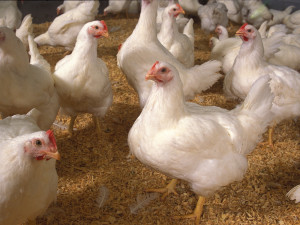09 Mar White Striping: What is white striping in chicken? Does white striping affect the nutritional value of chicken meat?
What is white striping? What causes white striping?
White striping is a quality factor in chicken breast meat caused by deposits of fat in the muscle during the bird’s growth and development. It is similar to marbling in red meat. White striping is not a food safety issue nor does it affect the welfare of the chicken.
Are bird sizes or faster growth rates causing white striping in chicken breast meat?

Some research has found that larger bird sizes can affect the cases and severity of white striping in birds, but research has not identified one single cause.
When white striping is detected, not all the birds in a flock are affected, even when they share the same genetics, management, feed, environment, etc. While all of the birds in a flock have a similar size and growth rate, some are affected with white striping and some are not.
“Slow growing” birds, organic birds and free range birds can all have white striping too.
Is chicken with white striping harmful or dangerous to eat?
White striping is not a food safety issue. White striping in chicken breast meat is absolutely safe to eat – there is no food safety concern. White striping is a quality factor in chicken breast meat caused by deposits of fat in the muscle during the bird’s growth and development.
Does white striping impact the nutritional value of chicken meat?
Chicken breast meat contains very low levels of fat. While there may be a slightly higher fat content in severe cases of white striped breast fillets in comparison to non-white striped breast meat, the overall fat content is still extremely low.
A European study found that white striping can increase fat by 224%, which sounds like a lot – but when starting fat content in chicken breast meat is only 0.5%, that doesn’t result in much of an increase at all. Other studies state a much lower increase in fat (224% vs. 84%); regardless, even a 100% increase would only double the amount (e.g., 0.5 to 1%), still resulting in low fat content.
How common is white striping in the U.S. poultry market?
Only a small percentage of chicken meat is affected by white striping. Mild or moderate striping may appear as very fines lines but it is not always noticeable. Severe striping usually means that it is visually apparent in the chicken breast meat.
Surveys of commercial chicken flocks show that between 12 and 43% of birds are affected by white striping. Furthermore, only 3 – 6% of the birds affected have severe cases of white striping. (Petracci et al, 2013; Lorenzi et al, 2014).
In most cases, severe white striped chicken meat is used in further processing and not sold in retail as boneless, skinless breast. So, when consumers purchase meat at the store, the meat does not have white striping.
Do muscle conditions like white striping cause pain and suffering in broiler chickens?
There is no data or research that indicates white striping negatively impacts the welfare of a bird. Birds affected by white striping have a healthy appearance and eating and drink, as expected – all of which are significant indicators of health and high welfare standards. Animal care specialists and farmers have not indicated any animal welfare problems, and continuous company and third party welfare audits have not indicated that white striping condition negatively impacts chicken welfare in any way.
Broilers chickens affected with white striping are often the larger birds in a particular flock which means they are not suffering or under any kind of stress that would be expected to reduce feed intake and hence growth rate. Just like people, when chickens are sick, stressed or in pain, they don’t eat. Birds affected with white striping exhibit good growth performance, livability and health – meaning they are eating and drinking well.
How are chicken producers responding to white striping?

Chicken producers are supporting research into the cause and prevention of white striping in chicken. Researchers are currently working on ways to reduce white striping through different feeds and ways of breeding the chickens.
In addition to USDA Food Safety and Inspection Service (FSIS) personnel inspecting chicken for issues that would affect food safety, chicken companies have employees in processing plants looking at every piece of breast meat for any quality issue. If severe white striping is found, the meat is typically diverted.
LOOKING FOR MORE INFORMATION?
Learn more about white striping from Janeal Yancey, a Meat Scientist and the blogger of Mom at the Meat Counter, and researchers, Dr. Christine Alvarado and Dr. Casey Owens.
To see what daily life is like for a conventionally raised broiler chicken, visit our “Day in the Life” section.

